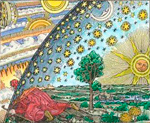Intensive Overview – Core Principles II
Houses of Heaven – Places of Earth
This post presents some key points of the presentation.

This Intensive focuses upon the identity and role of the western tropical zodiac and the twelve houses. Seeing how these two factors relate and function in astrology is another aim. In general overview western horoscopic astrology consists of a group of main building blocks – the planets, the tropical zodiac, the twelve-house system. Combining all of these with some other components, principles and techniques, will create a full horoscopic picture – known as an ‘astrological chart’.
These core components, the planets, the zodiac and the houses (as ‘stars’, ‘images’, ‘places’) have distinct identities and application. Fundamentally, each plays an independent role as a symbol-set in creating the entire horoscopic experience. In the historical heritage of astrology, they have developed their symbolism from separate informing principles which result in their unique purposes and functions.
So from the outset planets, signs, and houses have to be regarded as factors in their own right. This is in order to be able to understand how to interweave the principles and symbolism when it comes to actually doing full delineation. Otherwise the ‘language’ of astrology is compromised by a baseline lack of clear demarcation, the beginning symbolic meaningfulness is too diffused, and technique will ultimately suffer.
How is it that the planets, zodiac signs and houses are individual components? It is the philosophical division of the universal and the particular which begins to further differentiate the horoscopic purpose, function, and symbolism of the celestial and the terrestrial – which are two very clear categories. Simply put, the planets and the zodiac belong to the sky, universal to all under the heavens, they are therefore ‘celestial’ in nature. Whilst the houses concern dividing up space from the point of view of a particular longitude/latitude on planet Earth, and are therefore ‘terrestrial’ in basis.
The zodiac has been called the ‘sky without stars’, an arbitrary construct of images originally inspired by certain constellations. It has two essential uses, firstly a practical technical function, and secondly an archetypal symbolic function. It has been used in astrology since the invention of horoscopy in the Hellenistic era.
The sky without stars is also the sky of the ‘twelve towers’ or ‘signs’ of the zodiac; and these are not identical with the 12 zodiacal constellations contained in the sky of the fixed stars, but represent ‘virtual determinations’ of the celestial space …
Titus Burckhardt – Mystical Astrology According to Ibn Arabi
In contrast the houses are symbolic places which locate the celestial and universal within a terrestrial and particular context. Their meaning has developed due to a collection of factors, especially primary motion and spatial geography. In honouring the point of the celestial/archetypal being brought down to earthly context and meaning, it is therefore erroneous to conflate zodiacal and planetary symbolism with the meanings of the houses. In being a unique component with a unique informing tradtion, the houses cannot be ‘naturally’ elemental (fiery, earthy, etc ..) or ‘naturally’ zodiacal (Arian, Taurean, Geminian, …) or ‘naturally’ planetary (Martian, Venusian, Mercurial …).
This intensive was first presented in Brisbane (QFA) in March 2009, on the Gold Coast (GCAS) in April 2009, and on the Gold Coast (GCAS) in revised form in August 2012.
Contact the Astrology Project – Join the mailing list for regular information on Intensives and topics of astrological interest.